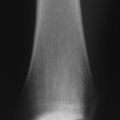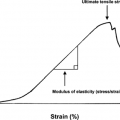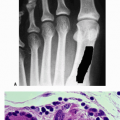Rothmund-Thomson Syndrome
Kathryn Palomino
Rothmund-Thomson syndrome is an autosomal recessive congenital syndrome (Box 7.5-1) associated with potential development of osteosarcoma. Since the patient usually arrives in the orthopaedic surgeon’s office with the diagnosis, the key for the orthopaedic surgeon is simply to recall the risk of development of osteosarcoma and to evaluate all musculoskeletal complaints in that context.
Pathogenesis
Etiology
Genetic defect: subset associated with defect in RECQL4 helicase gene at locus 8q24
Inheritance: autosomal recessive (AR)
Epidemiology
Rare
Incidence unknown
Male:female 2:1
Pathophysiology
Known genetic defect (RECQL4) present in 40% of cases
Normal expression highest in thymus and testes
Homology with genes that cause syndromes with some clinical overlap
Bloom syndrome: BLM gene defect on 15q26 with AR inheritance and increased incidence of osteosarcomas
Werner syndrome: WRN gene defect on 8p11-12 with AR inheritance and increased risk of various bone and soft tissue tumors
Diagnosis
Although no specific criteria have been established, generally the diagnosis is first suspected in the neonate based upon the characteristic rash that occurs within the first 6 months of life. Genetic testing may identify the characteristic defect in up to 40% of cases. Similar disorders, such as Werner syndrome, should be excluded (e.g., urinary testing for the characteristically elevated hyaluronic acid in Werner syndrome).
Stay updated, free articles. Join our Telegram channel

Full access? Get Clinical Tree






